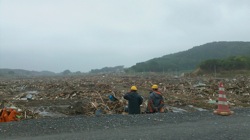Japan Visit
I recently had the great opportunity to visit Japan for the second time since the devastating earthquake and tsunami that struck on March 11th this year. My first visit was roughly 2 weeks after the disaster and at that time I spent most of my time in Tokyo coordinating ICT support to the NetHope members active in Japan. During my first visit, things were starting to get back into normal in the capital Tokyo, although almost constant aftershocks brought people back to the reality of what had occurred just a few weeks earlier. It was however great to see the tireless efforts of the various non-profit organizations to provide support to those affected. Even in a well prepared country like Japan, there are simply not sufficient government resources and expertise to deal with something of this magnitude.
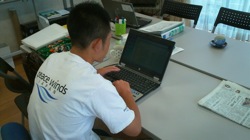
During this visit we handed out a total of 250 laptops to NetHope members and their local implementation partners. NetHope received these laptops as generous in-kind donations from Dell and HP and they were all configured ready to use, thanks to another generous donation, this of one of software from Microsoft Corporation. Getting them shipped over to Japan was also made possible by yet another generous donation, this one of shipping services from DHL.
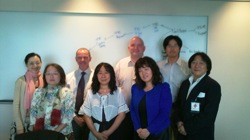
This time I spent half my time in Tokyo and the other half visiting the affected areas in Miyagi and Iwake prefectures. While in Tokyo I followed up on projects we started back in March and also had the great opportunity to attend the inaugural meeting of the NetHope Japan Chapter. This was the 12th local chapter we have established within NetHope. Local NetHope chapters play a very important role when disasters strike, because they enable coordination at the local level between the NetHope member organizations. It has often been said that having established relationships with other humanitarian organization is the key to successful coordination and we have seen this a number of times in countries that have local NetHope chapters when disaster strikes. Just knowing who your colleagues are allows for spontaneous coordination and collaboration to happen. During the inaugural meeting we also had representatives from our partners Cisco and Microsoft Japan (who graciously hosted the meeting). This is important as well, since it builds partnerships between the local NetHope members and the local offices of NetHope partners.
During my first visit, the phase of the disaster changed from the immediate rescue phase to the relief phase. Focus shifted from searching for survivors in the rubble to providing relief services to those that had survived. Most people had moved into evacuation centers and the main focus was to ensure they were receiving food, shelter and other basic services. It was therefore interesting that during my second visit there was also a change in phase. Focus was shifting from the relief services to recovery or reconstruction. Temporary housing has already been set up for a large portion of those affected and the plan is to move everyone out of evacuation centers by the end of the summer.
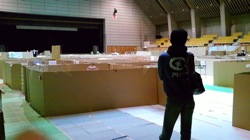
Although life in the evacuation center is no luxury, people sharing auditoriums and gyms with hundreds of other people, it also provided a safety net of some sorts for many people. While staying in the evacuation centers they got food, clothing and had access to other basic services, all for free. Moving into the temporary housing, although free, requires people to pay for electricity, food, telephone and other basic needs. This means that they have to find jobs to be able to afford these basic necessities. Many of those affected used to work in the fishing industry and due to the destructive force of the tsunami the boats, factories and harbors along the coast were all destroyed. A number of NetHope member organizations are working with local authorities in the affected communities on creating new livelihood opportunities for these people.
One of the great things about this trip was that I got Paul Chiswell, who is a director at our great partner and supporter Cisco to join me for the trip. Paul and I sit together on a sub-committee of the US State Department that focuses on ICT support during international disasters. During the initial weeks of the Japan earthquake/tsunami response, having relationships with people in the US State Department had helped us at NetHope tremendously in getting ICT equipment shipped over to Japan without it getting blocked in customs for days or weeks like so often happens. The US State Department and the FCC got us in touch with their counterparts within the Japanese government and as a result we were able to pre-warn the customs authorities that this equipment was coming and that since it was being used for relief services then it would not get stopped by customs. For him it was a great opportunity to see not only how generous support, both financial and in-kind in the form of networking equipment from Cisco had helped, but also to see how some of the work we had done in the sub-committee was already being put in practice.
Me and Paul visited the affected areas in Sendai and Shichigahama in Miyagi and Ofunato, Rikuzentakata and Kesennuma in Iwake prefectures. No words can describe the amount of destruction we witnessed. Close to 400km of coastline had pretty much been wiped out. Everything below 10-20m of altitude along the coast had been either seriously damaged or completely destroyed. What was however surprising was to see how houses built above the line of destruction had actually suffered less damage than I had expected. Reason for this was the fact that building codes in Japan are very strict and houses are built to withstand earthquakes. This is reflected in the fact that estimates are that only a few hundred people at most died in the earthquake itself. It was mainly the tsunami that followed that resulted in the massive loss of life.
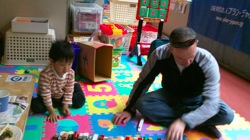
We had the opportunity to visit one of the evacuation centers to see how Plan Japan (local branch of NetHope member Plan International). In this evacuation center, Plan International has set up a child friendly space where the kids can come and play or do their homework. For those that have not been in an evacuation center it may be difficult to understand the concept of a child friendly space. But when you see how people live very close to each other, separated only by cardboard boxes you realize that the kids get very little possibility to play or talk to each other. The child friendly spaces are therefore a crucial place they can release some of that energy and also talk about some of the experiences they lived through. Plan has been working closely with teachers and psychosocial services in the affected areas, providing them with guidance on how to help the kids out dealing with the psychological effects of the disaster. It was very educational to visit the evacuation center, see how well organized they are and to better understand the conditions that people live in.
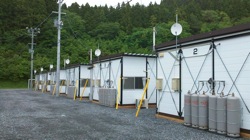
The day after we went to visit PeaceWinds Japan (PWJ) a local implementation partner of NetHope member MercyCorps. PWJ is working up in Iwate prefecture and we began by visiting their local office in Ichinoseki. The reason they set up the office in Ichinoseki is that even though there was some minor damage from the earthquake, most basic services such as electricity and telecommunications were available within days of the quake. The staff then drives on a daily basis down to the various smaller cities and villages along the coast where they were doing their job. We visited a new temporary housing facility that has been built in Ofunato. The temporary housing facility was built on a baseball field. The temporary “houses” are built together 6 in a row, similar to trailers, but they certainly would have given the famous FEMA trailers for Katrina a very bad name. All together there were 12 groups of houses like this, so in total there were 72 apartments. Every apartment had a small living room/kitchen and a sleeping room. They were also had electricity, TV and telephone installed in each apartment. We did notice that no internet connectivity was provided. We are however working on a project with Cisco Japan and Toshiba Japan to provide internet connectivity to some of these temporary housing facilities as well as tablet computers.
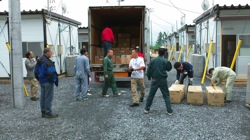
The temporary housing is provided with basic appliances such as fridge, washing machine and TV, but it is through support of non-profit organizations like PWJ to provide all the other things needed, such as plates, glasses, cleaning equipment, etc. When space permits there is also a community building next to the groups of houses, allowing for various social support services to be provided. These temporary houses are what many people will be calling their homes for the next two years. At that time, people are expected to move out of the houses into their own permanent housing.
The work in Japan is far from over. The debris and rubble is starting to be removed and people are moving into the temporary housing, but the psychological effects and the recovery efforts will take years. It is especially during this period that it is important to continue supporting the work of the great non-profit organizations that are doing an amazing thing supporting these people who lost everything. The spotlight of the media may be gone, but thankfully the spotlight of the non-profits continues to bring light to the life of the people affected. It is through the use of technology like NetHope partners provided as in-kind support that this work can be made more efficient and easier. At the same time we must also continue to improve preparedness for future emergencies. Scientists believe that the massive earthquake of March 11th has increased the likelihood of an quake in the Tokyo fault line which has the threat of affecting even a bigger population.

